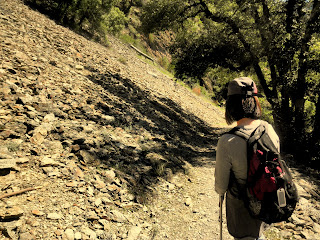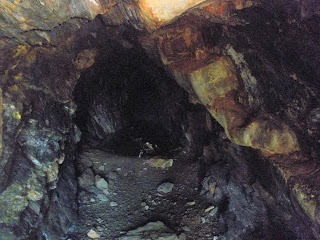
To get to the hike, you'll drive along 80 Reno to Alta, and then drive along small roads, eventually ending on a well maintained single lane dirt road that leads you across two railway tracks ultimately taking you to the trail head. This dirt road can be driven on by just about any vehicle; we drove a minivan and saw a prius at the trailhead, for example, so no OHV necessary to access the trail. At the trailhead, be respectful of private property signs. The people that live out in this area, I think, must truly value their private space. :)
Once you see this sign (below):
 . . . walk down the hill, and across the tiny creek (look for the 1950's car stuck in the tree near the creek):
. . . walk down the hill, and across the tiny creek (look for the 1950's car stuck in the tree near the creek):
Keep walking, looking for a small shady trail that leads you further down the hill. On that small trail, you should see, about 20 feet down the trail, this sign, nailed on a tree:
You'll also bump into this sign:
So--plenty of signs for the trail, which is helpful.
Below: a great view of the foothills, early in the hike:
For the most part, the trail, while switchbacky, is in forest, so it's a good summer hike (or late spring hike). You'll still need a hat and block, but the forest brings a welcome respite from the more exposed trails possible in the foothills.
The destination is certainly beautiful once you get to the river, however, and if you continue the trail, you get to cross the only pedestrian suspension bridge over the North Fork of the American River, which is kind of cool . It was built in 1965, and it's covered with graffiti from the early 70's, which is kind of interesting--lots of Rolling Stones references, for example. :)

Below: a mid-bridge view of the North Fork of the American River. Just up this view, a young miner apparently fell to his death; there's a memorial plaque later in the trail that tells you a little more about him.

As we explored the bridge, we noticed also old mining paraphernalia--big nails and a giant metal cable holder, possibly to build the bridge or possibly because this area was a big mining area in its past.
Once my kids had tested Gallileo's theory of big rocks falling at the same speed as little rocks by throwing rocks off the bridge, we kept walking up the hill to follow the left fork. This path was a narrow and perilous trail that ultimately leading us to a wooden sign nailed on a tree on the bank, memorializing "Jeffrey Allan Blondell--1956-1980--A good miner but a better friend." I don't know this young man's story, but I do like his memorial.

This part of the trail ends suddenly, but if you track back to the main trail, and continue up, you can backtrack to the main trail, and instead take the right fork all the way to Humbug Creek, finding more mining paraphernalia along the way. It was hot, however, and my two boys and small white dog were ready to return home, and we still had that long uphill switchback in front of us, so we had our lunch, and treked back up the hill for to the car.
Trail stats:
Trailhead to Euchre Bar--1.5 miles (but might seem longer due to switchback angles down/up)
Distance from home--about 80 mins
Trail surface--duff, loam, a few rocks. No scrambling. Well maintained. Shadey for the most part, but bring a hat and block.
DEFINITELY bring mosquito repellant. Those critters were HUNGRY on our hike, and we each emerged with at least 12 bites or so on our arms.










































